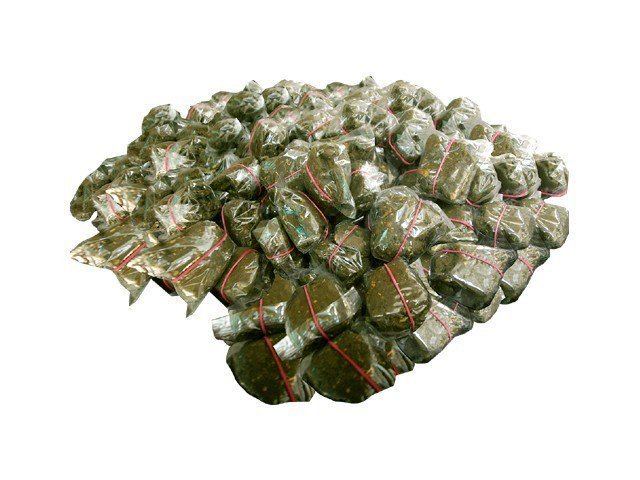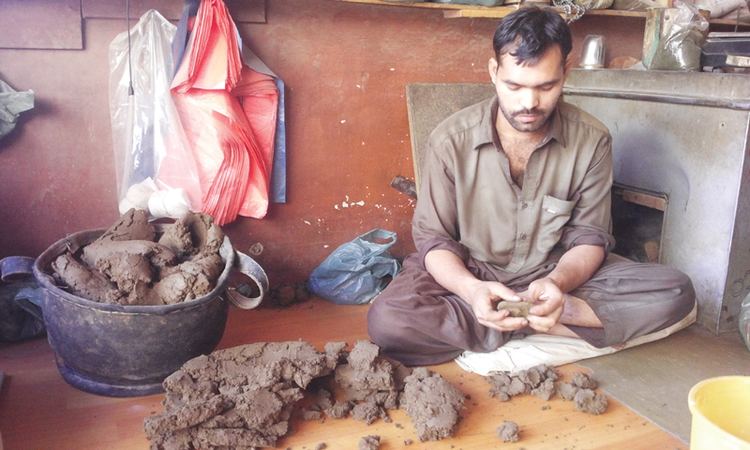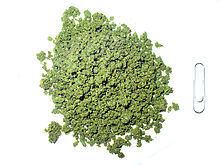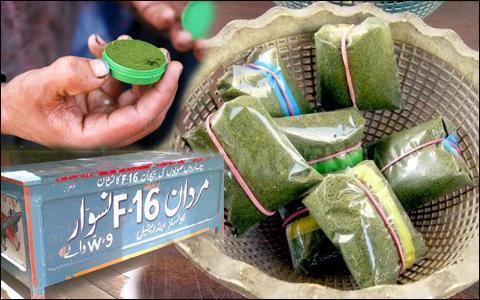Naswār (Pashto: نسوار; Cyrillic script: насва́р), also called nās (ناس; на́с), nāts (ناڅ; на́ц), or nasvay (نسوای; насвай), is a moist, powdered tobacco snuff consumed mostly in Afghanistan, Pakistan, India, Iran, Kazakhstan, Kyrgyzstan, Russia, Tajikistan, Turkmenistan, and Uzbekistan. Naswar is stuffed in the floor of the mouth under the lower lip, or inside the cheek, for extended periods of time. It is similar to dipping tobacco and snus.
Contents
- History
- Use in Afghanistan Pakistan and Central Asia
- Use in Russia and Europe
- Characteristics
- Cost
- Manufacture
- Controversy
- Side effects
- References

History

Naswar was introduced into Western Europe by a Spanish monk named Ramon Pane after Columbus' second voyage to the Americas during 1493-1496. In 1561, Jean Nicot, the French ambassador in Lisbon, Portugal, sent naswar to Catherine de' Medici to treat her son's persistent migraines.
Use in Afghanistan, Pakistan, and Central Asia

The green powder form is used most frequently. It is made by pouring water into a cement-line cavity, to which Lime (calcium hydroxide) or juniper is added as flavorings, and then air-cured, sun-dried, powdered tobacco is added. Indigo is added to the mixture to impart color.

Currently, the countries of the region freely sell naswar in the markets, usually on trays with cigarettes and sunflower seeds. The only exception is Turkmenistan, where in 2008 President Gurbanguly Berdimuhamedow signed a decree banning the production, sale, use, and import of naswar.
In 2011 naswar was included in the list of narcotic and psychoactive substances to be controlled in Kazakhstan.
Use in Russia and Europe
On the territory of Russia, naswar is not a traditional product, but it gained popularity in recent years especially among teenagers.

Naswar is sold in the markets of Moscow and in other cities of the Urals, Volga, and other regions of the country. Its trade is usually conducted on trays with spices, with naswar being bought as a means of nicotine addiction.
According to the association of tobacco distributors "Grandtabak", in the first half of 2004, Russia's import of naswar or "chewing tobacco" amounted to almost 67 tons (total value of 16,500 US dollars), primarily from Kazakhstan, Kyrgyzstan, and Tajikistan.
On 23 February 2013, the Russian State Duma signed a federal law (N 15-ФЗ) which banned both wholesale and retail naswar from 1 June 2013 onward (Part 8 of Article 19 of the Law) in Russia.
There are reports on physicians instructing their patients to use naswar in Belarus. In Estonia, naswar is being distributed to discothèques.
Characteristics
There are two forms of naswar; powder, and a paste cake style mixed with lime. A very pungent and powerful smell, yet a subtle flavor as it mixes with the saliva. The nicotine effect can occur within 5 minutes after intake producing a slight burn to the inner lip and tongue.
Naswar has a very distinct smell resembling that of a fresh bale of coastal hay.
Cost
Readily available in most Afghan tobacco shops, the average cost for a small 15 gram package is 10 afs (December 2013 exchange rate: 10.00 AFN ).
Manufacture
Sun and heat-dried tobacco leaves, slaked lime, ash from tree bark, and flavoring and coloring agents are mixed together. Water is added and the mixture is rolled into balls.
Nas: tobacco, ash, cotton or sesame oil, water, and sometimes gum.
Naswar: tobacco, slaked lime, indigo, cardamom, oil, menthol, water.
Controversy
In November 2006 an editorial in the newspaper Daily Times in Pakistan caused some controversy over its allegedly biased representations of Pashtun predilection for naswar.
Side effects
The major side effect of using naswar is addiction, and it becomes difficult to get rid of it. As the lime is added, it is also increasingly known that naswar often causes oral and throat cancer.
